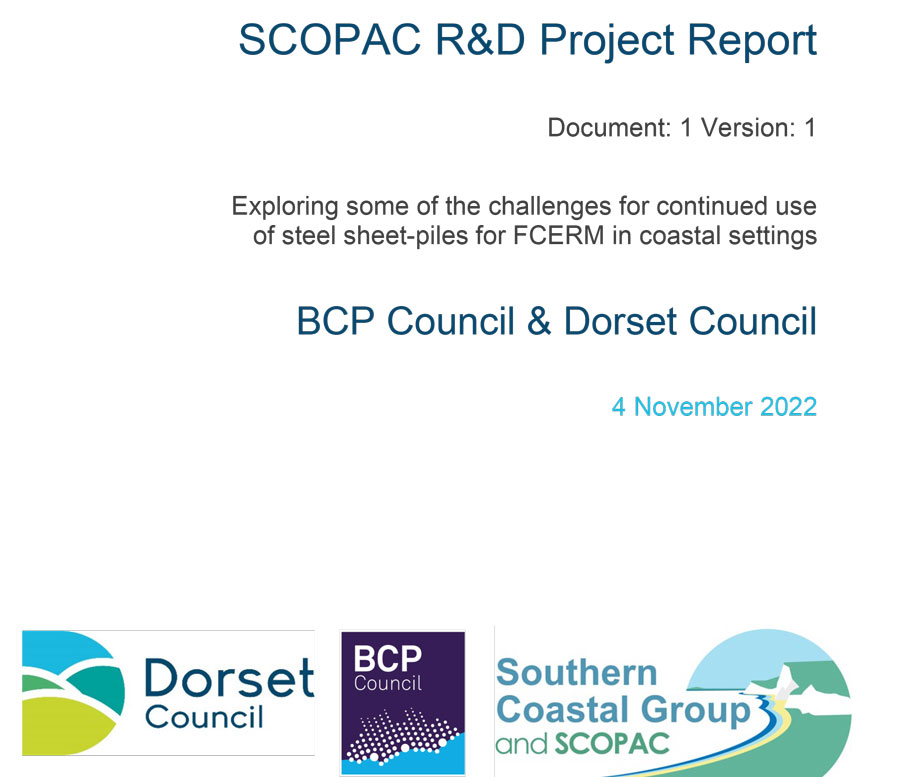Exploring some of the challenges for continued use of steel sheet-piles for FCERM in coastal settings
SCOPAC Minor funds contribution 2020-2021 \ Rob Thomas, Dorset Council and Alan Frampton, BCP Council: £4,000
Background
In the SCOPAC region (and elsewhere), Risk Management Authorities (RMAs) maintain many FCERM assets that comprise steel sheet pile walls. These walls are known to suffer from Accelerated Low Water Corrosion (ALWC) problems, and as such many of these walls use surface corrosion protection systems such as cathodic protection to extend the life of the piles, with varying degrees of success.
The use of steel sheet piles to replace existing ones is often identified as the preferred long-term approach to ongoing coastal flood risk management in these areas (as opposed to retaining, or changing to, masonry/concrete solutions). In setting this long-term strategic direction, two or three periods of steel sheet pile replacement over a 100-year appraisal period are frequently included in the economic case in recognition of the rate of degradation of steel sheet piles in the marine environment; this is not always compared to the whole life costs associated with concrete/masonry walls which are typically designed to be constructed once in a 100-year appraisal period with a service life of 100 years or more (CIRIA, 2010; CIRIA, 2015).
If steel sheet piles are to continue to be the preferred way of managing coastal flood risk in these areas into the longer-term, then there is a need to understand how the scheme design life of these assets can be extended beyond current day levels using corrosion protection systems such as cathodic protection in order to maximise investments.

Weymouth Harbour Walls (Dorset Council)
Aims & Objectives
The aim of this research was to undertake a desk-based study of some of the challenges posed by long-term approach to FCERM using steel-sheet piles compared to other methods (i.e. masonry and concrete walls), in order to illustrate these challenges to prompt discussion in the wider industry. This aim was achieved by focussing on experience at Weymouth Harbour as a case-study location, where there is range of information about all three wall types that have been installed over decades and centuries in the same system, so allowing for ready comparison of the rates of deterioration of steel sheet pile walls to other construction types.
In achieving this aim, the following objectives were met:
1. Understand the rates of deterioration of the various steel sheet pile and corrosion protection systems used in walls around Weymouth Harbour. To include:
(a) Comparison of actual experience at Weymouth (as far as possible) with (i) what manufacturers expectations are with the same pile / corrosion protection systems, and (ii) EA asset deterioration curves suggest should be expected, accounting for levels of maintenance of the Weymouth assets over the years.
(b) Comparison to the deterioration rates of steel sheet piles to those of concrete and masonry walls around Weymouth Harbour.
2. Describe the technical and environmental challenges of repeatedly upgrading sheet pile walls using further sheet piles, including learning the lessons of recent works in parts of Weymouth Harbour and preliminary environmental assessment findings from the recent coastal processes study and FCERM Strategy update.
3. Undertake a high-level assessment of the relative whole-life costs over a 100-year strategic appraisal period of different wall construction types, including sensitivity to different maintenance levels and associated wall replacement frequencies and how these may be impacted by climate change (which will affect rates of asset deterioration in different ways for different wall types (Environment Agency, 2017c).
4. Undertake a high-level assessment of the whole-life carbon budget for different wall construction types using the Environment Agency’s Carbon Modelling Tool (Environment Agency, 2019).
Outputs

SCOPAC R&D Project Report, November 2022
A technical report has been produced that shares the findings and lessons learnt from achieving the research aim and objectives in a way that can be used to inform future decisions by RMAs when considering future wall replacement options and ongoing maintenance levels. It also identifies current gaps in knowledge where further research would be helpful.
Download the report (PDF, 2Mb)
- The findings were presented at a SCOPAC Research webinar on 13th October 2023.
References
CIRIA, 2015. Old Waterfront Walls. CIRIA Report C746.
CIRIA, 2010. The use of Concrete in Maritime Engineering. CIRIA Report C674.
Environment Agency, 2019. Operational Instruction 120_16: Whole Life (Construction) Carbon Planning Tool User Guide. 12th December 2019.
Environment Agency, 2017c. Impacts of Climate Change on Asset Deterioration: Appendix B. Defra/EA FCERM R&D Programme.
